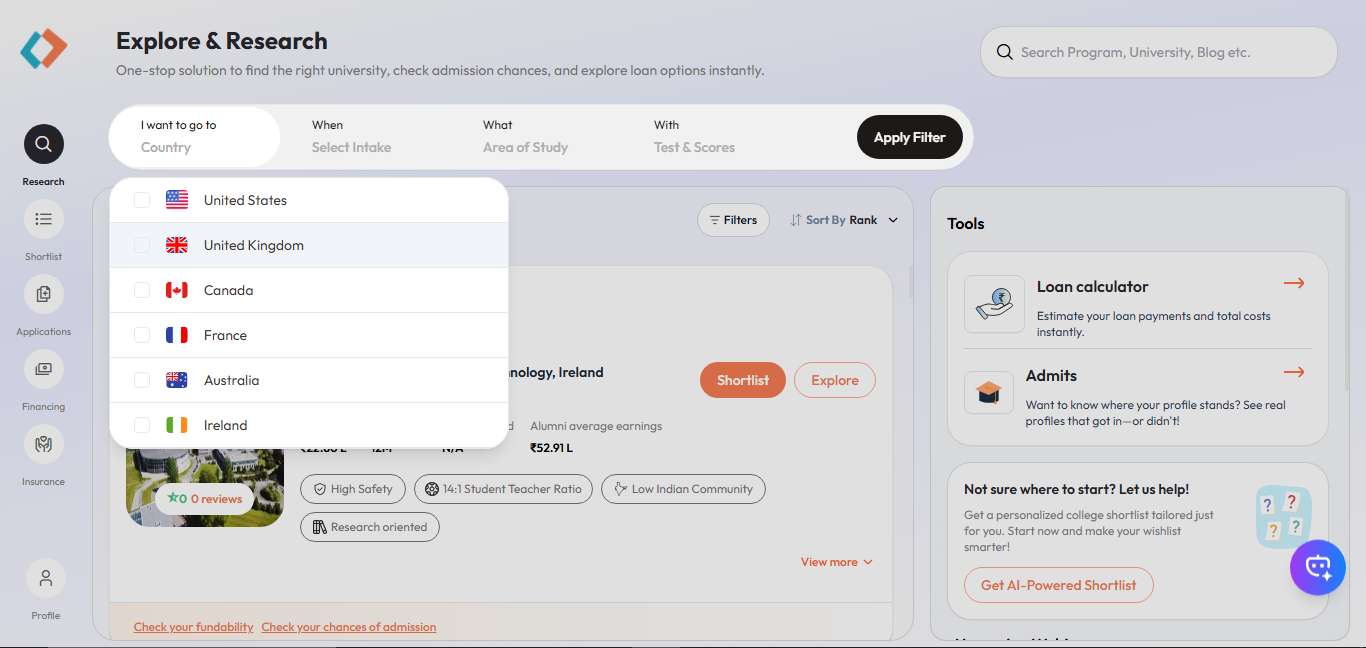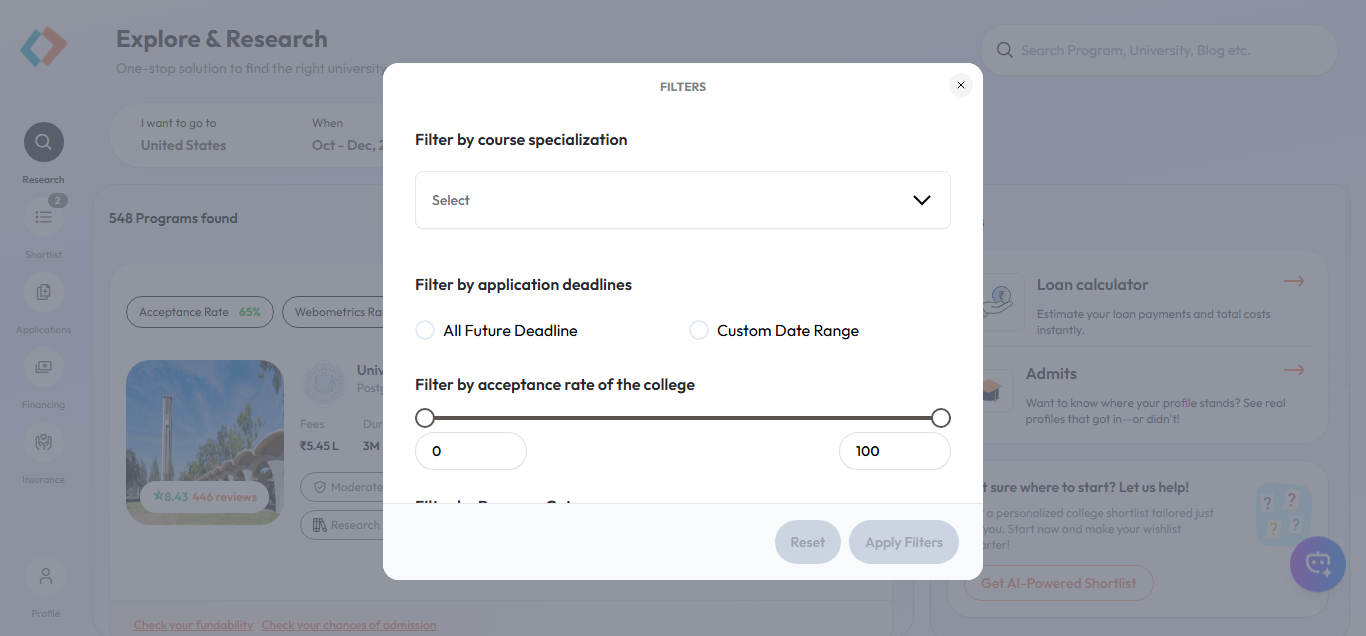If you are considering studying abroad for your Master’s, university tuition fees are probably one of the first things on your mind. Sure, you first have to ask yourself some important questions about the field of study based on your academic goals, personal values, and long-term aspirations.
However, after deciding on your master’s specialization or area of interest, the next big question is: how much are you willing to invest? Studying overseas can come with a big price tag. You don’t want to burden your parents with hefty loans or expenses.
Some studies have also shown a positive correlation between high student debt and college dropout rates, with every $1,000 increase in debt raising dropout chances by 3%.

So, while university rankings and course content are important, your budget plays a huge role in deciding which university is right for you. Some countries and universities are far more affordable than others. For instance, some European countries like Germany and Norway offer tuition-free public universities. On the other hand, top universities in the USA and UK are some of the expensive to attend.
To reduce all the stress and hours of research involved in selecting the best university, GradRight has come up with a simple solution. GradRight’s university search platform allows you to filter universities by tuition fees and other important factors. This blog will help you learn how to use GradRight’s smart filters to find a university that fits your budget, across thousands of universities in top study destinations in the world.
Why tuition fees matter when choosing a university abroad
University tuition fees do always impact an international student’s overall financial planning. A year of tuition in the UK might cost between US$11,000 and US$55,000. Tuition fees in the USA can be upwards of US$50,000 per year, and the same in Australia ranges between US$16,000 and US$47,000 per annum.
Your university tuition fee will, thus, be one of the biggest and most foreseeable study-abroad costs.
Here are some reasons why university tuition fees should matter to you:
- High tuition fees can increase your student debt and this makes budget an important yardstick when choosing your university abroad. If you pick a university with affordable tuition, you can manage financial obligations without putting stress on yourself or your family in the future.
- Tuition fees will also influence decisions regarding financing your studies abroad. You can plan your budget better and avoid running into money troubles later.
How you will fund your education: scholarships, part-time work, loans or other financial aids, all depend on how much tuition you need to cover.
- Understanding tuition costs helps in judging the potential ROI of a degree. Try to think of your education as an investment in your future. Some universities may cost more but offer high-paying jobs in top companies after graduating. They may also include a stronger alumni network and placement support.
For this reason, it is important to compare the fee with what you might learn.
GradRight allows you to do just that. Students can identify universities that align with their financial capabilities while meeting academic goals. GradRight’s university search platform filters universities based on different criteria, including rank, budget, and acceptance rate.
How GradRight’s university search platform filters universities by tuition fees
GradRight’s university search platform tool simplifies your selection process. It uses an AI algorithm that analyzes over 40,000 programs across various criteria and allows you to filter universities in a fraction of the time.
Here is a step-by-step guide on how to filter and find affordable universities on GradRight’s university search platform:
- Start your university screening on the Explore & Research page by selecting your primary filters. The ‘Where, When and What’ of your study abroad plan. These include the country, enrolment month, and area of study.
- First, tick your preferred country from six options. You can pick one or more.

- Next, select the months you plan to pursue your higher education in.

- Choose the area of study for your master’s programme.

You have an option to select ‘Programs without Aptitude Tests.’ However, you can also enter your aptitude and/or language test scores for a better match. The test options are GRE, GMAT and IELTS, among others.

- After you have chosen the primary filters, click on the ‘SortBy’ option and choose ‘Budget’.

This will give you all budget university options in descending order of fees, based on your preferred country and field of study. You can now easily browse different affordable study abroad programs and compare their other features.
- To note more details, you can also shortlist universities and see the cost breakdown of education expenses abroad.
For example, if you want to study Management in the UK, the University of Derby offers some of the lowest fees. See the breakup of the costs with the university fees guide by switching to the ‘Shortlist’ page.

- You can filter university programs with another set of secondary filters on the ‘Research page.’ These filters let you narrow down universities by:
- Course Specialization – e.g., Risk Management, Public Policy, or Actuarial Science
- Application Deadline – option to choose a custom date range
- Acceptance Rate of the College – to understand your chances of admission
- Program Category – such as STEM, Business, or Humanities
- Location – filter by city or state preferences in a particular country
- Campus Safety Ratings – option to choose from a scale of 0 to 100

GradRight also lets you chat with an expert advisor to refine your selection. You can set one-on-one advisory sessions. You can connect with alumni, faculty, and peers from the shortlisted universities or attend webinars to ask questions and learn from real experiences.
Understand different fee structures for domestic vs. international students
When you compare tuition fees to find the best affordable colleges abroad, it is important to know that universities charge differently for domestic and international students. These differences can be quite big.
The difference in university tuition fees is usually based on government funding and residency status. Domestic students pay much lower fees because their government supports or subsidizes education.
For instance, in the UK, “Home” students at public universities pay a fixed, lower rate. Likewise, domestic students in Australia can access Commonwealth Supported Places (CSP), which means part of their fees are covered by the government. They only pay a smaller share called the Student Contribution Amount.
International students normally have to pay higher university tuition fees since they are not eligible for local subsidies.
| Domestic Students | International Students | |
| Tuition Fees | Subsidized; lower costs | Higher fees due to lack of subsidies |
| Scholarships | Fewer scholarships | More scholarships |
| Additional Costs | Minimal | Visa fees, travel expenses, health insurance and more |
This difference is important for setting your budget or comparing universities on your own. However, GradRight lets you view and compare tuition fees and the cost of living for each university.
Use GradRight to compare tuition fees across different countries and programs
GradRight’s university search platform also lets students compare university tuition fees across different countries and programs. As mentioned above, you can filter budget universities by location and area of study.
Filter by Country
Use the country-specific filters to narrow down universities in different study destinations. GradRight’s university search platform integrates real-time currency conversion tools to display tuition costs. You can easily compare university fees side by side in INR.
Filter by Area of Study
After choosing your preferred field, you can compare tuition fees across different programs, including a diploma, a postgraduate certificate, or a full-time master’s degree
Once you have shortlisted low-cost universities on the ‘Research’ page, you can compare them based on different criteria. Simply switch to the ‘Shortlist’ page and compare your selected programs on tuition fees, placement records, alumni networks and more.
This comparison will help you judge the financial viability and overall value of each programme.
Let’s say you selected two universities with low tuition for your management master’s course in the USA and the UK. The University of California Riverside and the University of Derby both offer some of the lowest fees in their respective countries. But how do they stack up against other parameters, such as ROI, living expenses, and scholarships?
Click on ‘View More’ to find a detailed comparison with key data points. It shows the median earnings after graduation at 5 years, along with other university features. These include campus safety, Indian community presence, and how tuition lines up with the cost of living.
Beyond university tuition fees, GradRight also displays additional expenses such as living costs specific to each country.
Other Financial Considerations Beyond Tuition Fees
University tuition fees are undoubtedly one of the most important budget factors, but it is not the only piece of the puzzle. There are several costs that you might miss when planning your total study abroad expenses. For example, in Germany, many public universities offer free tuition for international students.
However, there are other costs to consider that can seriously impact your overall budget.
Living Costs
Rent is usually the biggest monthly expense you will face while living abroad. Private apartments close to your university can be expensive. Other financial considerations include your basic daily needs such as groceries and eating out expenses. These expenses are higher for certain countries like the USA and can cost anywhere from $5,200 to $7,000 per month.
Health Insurance
Health insurance is a mandatory expense that most students overlook during budgeting. Since health insurance is mandatory in most countries, you must purchase a valid plan before enrollment. Many universities in the USA offer a university-sponsored plan that is included in your tuition fee. However, you can also opt out of that and buy yourself a private insurance plan. These can cost anywhere between $30 to $100 per month.
Books and Study Materials
Textbooks and other study materials can also be big annual costs, costing about $200–$900 per year. You can buy second-hand books or use e-books to save on study expenses. However, some scholarships cover study material costs.
You can also check out GradRight scholarships to study abroad and get some help with financing your studies.
Currency Exchange Rates
You also have to keep in mind that exchange rate fluctuations can affect your total spending. Countries with stable or favorable exchange rates can help you save in the long run.All in all, understanding these additional costs along with tuition fees will give you a realistic picture of what your study abroad journey will truly cost. It will help you avoid surprises and make smarter financial decisions.
FAQs
1. Which country has the cheapest university fees?
European countries like Germany, France and Norway offer some of the cheapest universities abroad for Indian students. The public university programs in these countries have zero or low tuition fees for non-EU members, too.
2. Do higher tuition fees impact student dropout rates?
High university tuition fees can lead to increased loan requirements, which can, in turn, encourage high debt. Increased student debt has been known to discourage enrollment, especially for low-income and minority students. Moreover, loans over US$10,000 often lower graduation rates and harm educational success.
3. Is 20 lakhs enough to study abroad?
INR 20 lakhs can be enough to study abroad if you choose affordable countries like Germany or Norway. However, scholarships and smart budgeting can also help fund your studies abroad on a budget. Talk to a GradRight study abroad expert for personalised advice.
4. How can I filter universities based on tuition fees using GradRight?
Students can easily filter universities by tuition fees on GradRight’s university search platform. You can start by entering your academic details and selecting the ’Budget’ option on the homepage. The AI tool then matches you with preferences with thousands of universities and gives a list of programmes in descending order of tuition fees. You can further filter universities with several other criteria and make the best choice for your study abroad plans.
5. What other criteria can I filter universities by on GradRight?
Apart from tuition fees comparison, GradRight’s AI-powered platform lets you filter universities by university rankings, program details, location, acceptance rates, campus safety and test scores. You can find the right fit for your academic goals and budget with minimal effort.















